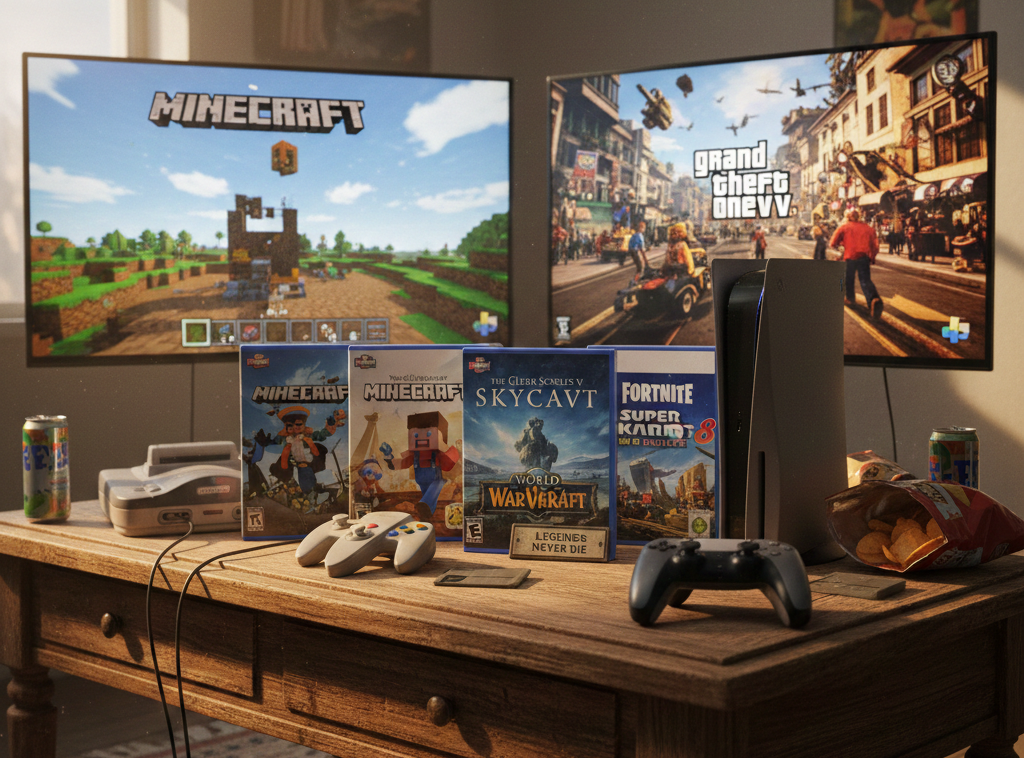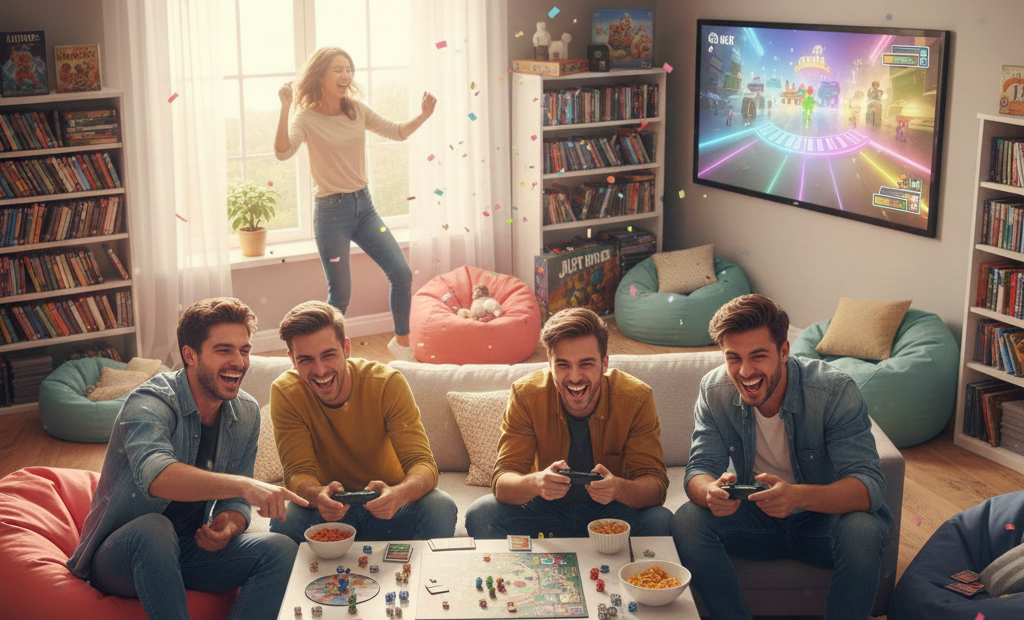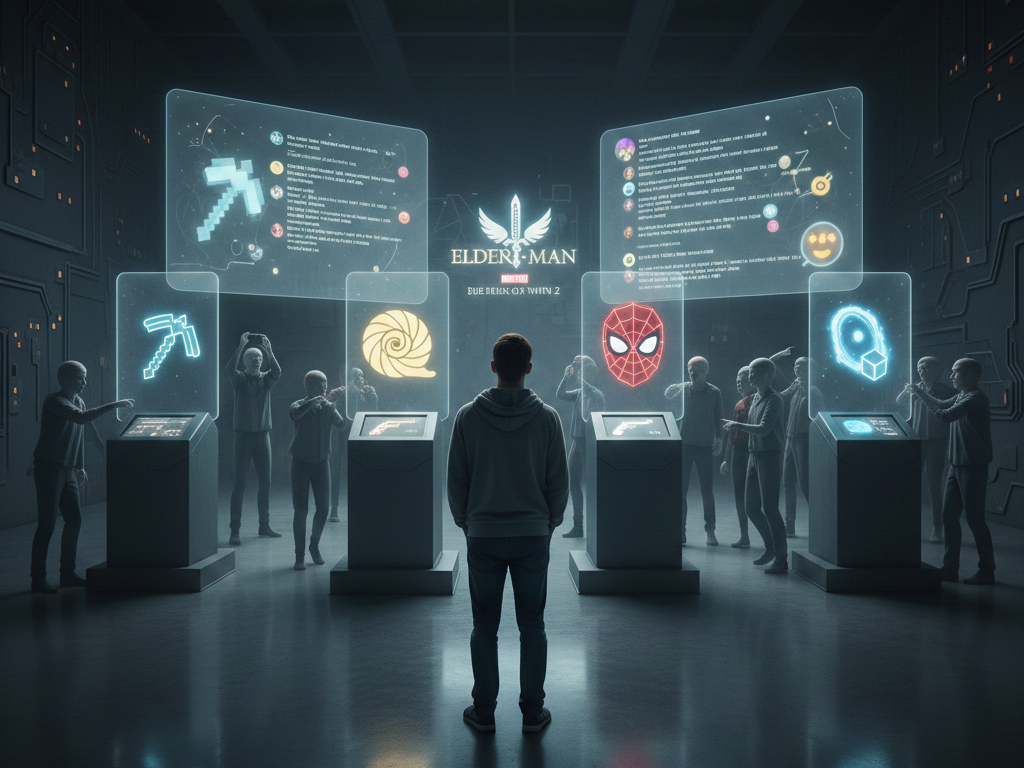Anúncios
Have you ever thought about how gaming could help you recover from a stroke or multiple sclerosis? The field of neurological rehabilitation is now using new methods, like VR games. These games are not just for fun; they help patients improve their grip strength, dexterity, and fine motor skills.
VR technology makes rehab more fun and engaging. It adds a competitive element to traditional practices. In this article, we’ll see how these games can change rehabilitation. They help patients get better at daily activities by improving their grip, dexterity, and fine motor skills.
Anúncios
Introduction to Neurological Rehabilitation
Neurological rehabilitation helps patients recover from serious conditions like strokes and brain injuries. It focuses on improving muscle strength and motor skills. These are key for everyday activities.
Traditional rehab often focuses on the lower body, leaving the upper body behind. This neglects grip strength and dexterity. Focusing more on the upper body can greatly improve patient recovery and independence.
New methods, like virtual reality games, offer exciting possibilities. They create interactive environments for skill development. This approach targets specific motor skills and muscle strength, leading to significant progress in rehabilitation.
Anúncios
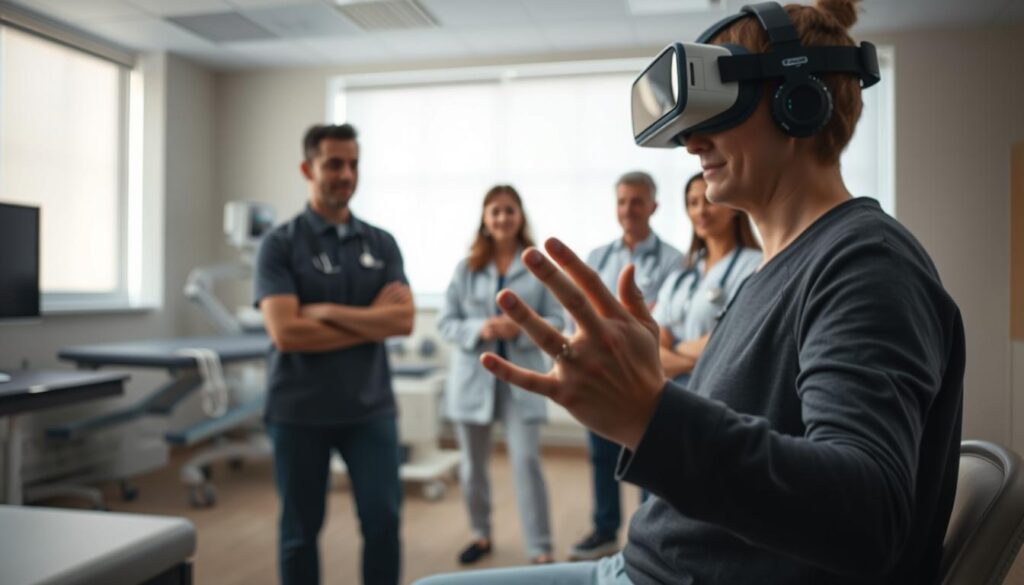
The Importance of Grip Strength in Recovery
Grip strength is key in the recovery process for those in rehab. Studies show that better grip strength means better arm function and more independence. For people with neurological issues, being able to do everyday tasks depends a lot on their grip.
Working on grip strength helps people regain their physical abilities and feel more confident. Using new methods like virtual reality games can make rehab more effective. These games make learning fun and help improve grip strength.
By focusing on grip strength, people can become more independent and enjoy a better life. It’s a big step towards regaining control over their movements.
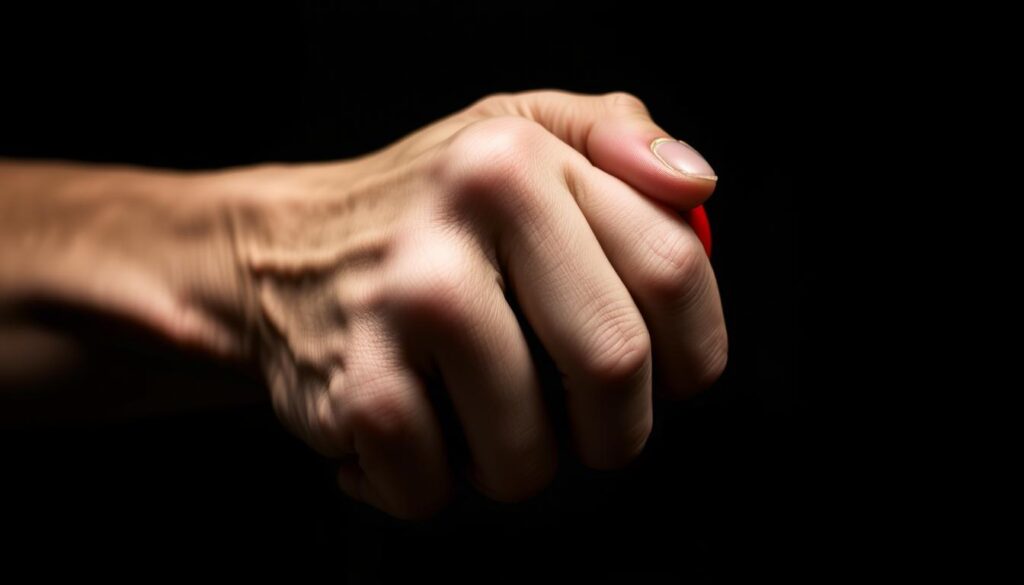
Understanding Dexterity and Fine Motor Control
Dexterity and fine motor control are key to our daily lives. They help us do things like write, button shirts, and take care of ourselves. These skills use small muscle movements in our hands and fingers. This lets us handle objects with great precision.
For people recovering from neurological disorders, improving these skills is very important. Disorders like multiple sclerosis and stroke can weaken muscles and disrupt brain signals. This makes it hard to do fine motor tasks.
Rehabilitation programs focus on enhancing dexterity and fine motor control. They help patients regain their independence. This improves their quality of life.
Interventions that target these skills help patients recover and gain confidence. Innovative therapies and engaging rehabilitation practices lead to better functional abilities. This is a big step forward for those facing challenges.
How VR Technology Enhances Rehabilitation
VR technology changes the game in rehabilitation by making therapy fun and engaging. It creates worlds where patients do exercises in a fun way. This makes therapy more enjoyable and boosts motivation.
VR uses interactive training to keep users hooked. It makes following the therapy plan easier and more fun. This way, patients stick to their rehabilitation plans better.
VR also gives patients instant feedback on their actions. This feedback helps them learn and improve faster. It shows them how they’re doing and helps them get better.
Moreover, VR offers personalized therapy plans for each patient. Unlike old methods, VR can adjust to each person’s abilities. This makes therapy more effective and enjoyable for everyone.
Overview of VR Grip Strength Training Games for Neurological Hand Rehabilitation
VR grip strength training games are a new tool in hand rehabilitation. They are made to improve grip strength in a fun way. This helps patients recover from many neurological conditions.
These games use VR to make hand therapy more exciting. Players face challenges that need hand strength and skill. This helps with both physical and mental recovery.
Games for conditions like multiple sclerosis use advanced tech like the Leap Motion Controller. It tracks hand movements accurately. This lets players see how they’re doing and set goals.
There are many VR games for different needs in hand therapy. They make therapy fun and show progress. This makes them a great help in hand rehabilitation.
Benefits of VR Games in Physical Therapy
Virtual reality (VR) games in physical therapy offer many benefits. They make recovery more fun, boosting patient motivation. This makes therapy more enjoyable, helping patients stick to their treatment plans.
VR games create an exciting space for focused practice. This helps patients meet their physical therapy goals. They see real progress and feel a sense of achievement as they tackle game challenges.
Studies show VR can improve physical results in therapy. It also makes patients happier with their treatment. VR games help both physically and emotionally, which is key in healing.
Evaluating Video Games for Rehabilitation Effectiveness
Checking how well rehabilitation games work is key to knowing their impact on recovery. First, we set clear goals that match what we want to achieve. This means improving grip strength, coordination, and overall function in a safe way.
VR’s success can be measured in many ways. Tools like the Barthel Index and the Fugl-Meyer Assessment show how well patients are doing. By looking at these, doctors can see how VR games compare to traditional methods.
How happy patients are also shows VR’s worth. Surveys help us understand what patients think and feel. When they’re happy, they’re more likely to stick with their treatment plan.
Using both what patients say and numbers to measure success gives a full picture. This approach shows not just physical gains but also emotional and mental health benefits. It shows VR therapy’s wide-ranging benefits.
Types of Virtual Reality Games for Neurorehabilitation
The world of neurorehabilitation has changed a lot with VR games. These games are made to help with different needs. They work on improving motor skills, coordination, and thinking.
There are many kinds of VR games for therapy. Each one has its own goal:
- Motor Skills Training: These games make patients move in new ways. They help with big and small motor skills.
- Coordination Games: Players do tasks that boost hand-eye coordination. This is key for everyday tasks.
- Cognitive Function Games: These games make your brain work harder. They help with memory and solving problems, which is good for therapy.
It’s important to know how these games help in neurorehabilitation. Each VR game is made for a specific need. They use cool tech to keep users interested and help them get better faster.
Popular VR Grip Strength Training Games for Neurological Hand Rehabilitation
Virtual reality is changing the game in neurological rehabilitation, especially for grip strength. Many VR games focus on improving grip strength and fine motor skills. They make rehabilitation fun and effective.
Racket Fury: Table Tennis is a great example. Players enjoy realistic table tennis while working on grip strength. Beat Saber is another hit, where players cut through blocks in time with the music. It’s all about grip control and rhythm.
Games like these use advanced tech, like the Leap Motion Controller, for precise hand movements. This tech tracks detailed finger actions, making these games perfect for upper limb rehab. These VR games make therapy fun and interactive, boosting patient motivation.
Game 1: Piano Game
The Piano Game is a fun and interactive way to improve grip strength and dexterity. It uses VR game mechanics to make playing a virtual keyboard a real challenge. Players must move their fingers quickly and accurately to keep up with the game.
This game makes learning feel real and exciting. It’s perfect for helping people get better and learn new skills.
Description and Mechanics of the Piano Game
In the Piano Game, players tap on keys as they see them on the screen. The game tests their timing and accuracy. It’s like a race to see who can press the right keys first.
It’s not just about playing the right notes. It’s about moving your fingers fast and right. The game gets harder as you get better. This keeps players motivated to keep improving.
Impact on Grip Strength and Dexterity
Playing the Piano Game can really help your grip strength and dexterity. It’s like doing hand exercises, but it’s fun. Pressing keys over and over strengthens your hand muscles.
Studies show that people who play these games a lot get better at using their hands. It’s a great way to help people recover from injuries or illnesses.
| Aspect | Piano Game | Traditional Rehabilitation |
|---|---|---|
| Engagement Level | High (Interactive and fun) | Moderate (Repetitive exercises) |
| Skill Development | Targeted Finger Movement | General Hand Exercises |
| Grip Strength Improvement | Yes (Measurable gains) | Possible (Varies) |
| Motivation | Gamified challenges | Limited (Routine based) |
Game 2: Reach Game
The Reach Game is a new way to do VR therapy. Players move their arms to grab virtual objects. This makes their arm movements better and more functional.
This game is fun and helps with real-life tasks. It’s great for therapy.
Description of Gameplay Mechanics
In the Reach Game, players use their body to move their arms. They reach for virtual items. The game tracks their movements with technology.
Key parts of the game include:
- Dynamic feedback for each movement, allowing users to adjust their reach accordingly.
- Variety of virtual objects at different distances and heights, promoting diverse arm movements.
- Progress tracking to motivate participants and set goals for upper limb recovery.
Benefits for Upper Limb Recovery
This game is a strong tool for recovering upper limbs. It helps players do tasks like reaching for things on a shelf. Studies show VR therapy works well.
Benefits of the Reach Game include:
- Improved motor skills through repeated practice in a safe environment.
- Enhanced hand-eye coordination as players learn to task their limbs effectively.
- Increased engagement and motivation due to the interactive and immersive nature of the gameplay.
Game 3: Sequence Game
The Sequence Game is a unique way to use VR for rehabilitation. It focuses on memory and sequencing skills. Players must remember and repeat a series of movements. This helps with physical and cognitive functions.
This game is great for those doing neurological hand rehabilitation. It combines movement with memory training. This makes it very helpful for recovery.
The game requires repetition and practice. These are key for improving grip strength and dexterity. Players do tasks that test their spatial awareness and motor planning.
It also helps with dual-task training, which is important for daily activities. Players face real-life challenges and work on their responsiveness and adaptability. As they progress, they improve their functional capacity and make big strides in recovery.
Comparing Traditional Rehabilitation to VR Games
Traditional rehabilitation has been key for those with neurological issues. It includes exercises to boost strength and coordination. But, studies show VR games can make therapy more effective.
VR games offer unique benefits. They make therapy more fun and engaging. This can lead to better results.
VR therapy can sometimes beat traditional methods. It boosts motivation and makes recovery feel more achievable. This positive mindset can improve physical skills.
| Criteria | Traditional Rehabilitation | VR Games |
|---|---|---|
| Patient Engagement | Moderate | High |
| Motivation Level | Variable | Consistently High |
| Feedback Mechanism | Limited | Instant and Interactive |
| Accessibility | Requires Therapist | Can be Self-Administered |
| Rehabilitation Effectiveness | Well-Established | Promising, with Emerging Evidence |
While traditional methods are still important, VR adds new ways to help. It shows a shift towards more fun and effective therapy.
Future of VR in Neurological Rehabilitation
The future of VR in rehabilitation looks very promising, especially for those with neurological conditions. New advancements in therapy are making immersive technology a big part of clinical practices. As neurorehabilitation technology gets better, we see more advanced uses of VR, changing how patients experience and achieve results.
VR games and better hardware are leading to therapy options that fit each patient’s needs. These improvements make therapy more fun and interactive. VR creates real-like environments, turning therapy into a game rather than a chore.
VR technology is also very flexible. It meets different recovery levels and can be tailored for each patient’s goals. As healthcare professionals keep exploring VR, the future of VR in rehabilitation is looking very bright. It promises new ways for people to recover.
| Advancements in Therapy | Potential Benefits |
|---|---|
| New VR Games | Enhance engagement and motivation |
| Improved Hardware | Increased realism and user experience |
| Customizable Therapy Solutions | Address specific patient goals |
| Real-time Feedback Systems | Monitor progress and adjust accordingly |
| Integration with Traditional Methods | Combining strengths of both approaches |
Conclusion
VR games are changing how we help patients recover. They make therapy fun and effective. This is great for people with motor challenges.
These games help improve grip strength and dexterity. They make physical therapy enjoyable. This is thanks to the latest VR technology.
VR games do more than just motivate. They offer experiences that fit each patient’s needs. This is key for their recovery.
Keeping these games up to date is important. It ensures they work well in clinics. This is good for patients’ independence and quality of life.
VR technology is key for future rehab. It makes therapy more effective and focused on the patient. This approach helps both physical and mental health.
Improving VR solutions is crucial. It will shape the future of rehab. We’re just starting to see its potential.
FAQ
What are the benefits of using VR games in neurological rehabilitation?
VR games make therapy fun and engaging. They help improve grip strength, dexterity, and fine motor skills. This is key for daily tasks. The immersive experience also helps patients stick to their therapy plans, leading to better results.
How do VR games specifically target grip strength?
VR games for grip strength have special mechanics. They challenge hand muscles in a fun way. Feedback helps patients get better with each try, making therapy more effective and fun.
Are VR games suitable for all patients with neurological conditions?
VR games work well for many patients, but it depends on each person’s abilities. Always talk to a healthcare professional to see if VR therapy is right for you.
Can VR technology be used in conjunction with traditional rehabilitation methods?
Yes, VR can add to traditional therapy. It offers new ways to improve upper limb function. This can help patients recover more fully and get the most out of their therapy.
What types of neurological disorders can benefit from VR rehabilitation?
VR helps patients with stroke, MS, brain injuries, and more. It’s especially good for those with motor or cognitive issues. The fun nature of VR can really help motivate patients to recover.
How is the effectiveness of VR games in rehabilitation measured?
Effectiveness is checked with tools that look at grip strength, coordination, and how happy patients are. Things like how well patients do, what they say, and specific goals are met help show VR’s benefits.
What are some examples of VR games used for grip strength training?
Games like the Piano Game, Reach Game, and Sequence Game are great for grip strength. They use different ways to help patients improve their hand skills and think better.
What advancements are being made in VR rehabilitation technology?
New VR tech includes better environments, more feedback, and games for specific needs. These changes aim to make therapy more effective and enjoyable for patients.
How does VR promote patient engagement during therapy?
VR makes therapy fun and interactive. This keeps patients interested and encourages them to practice regularly. This is key for reaching therapy goals.


